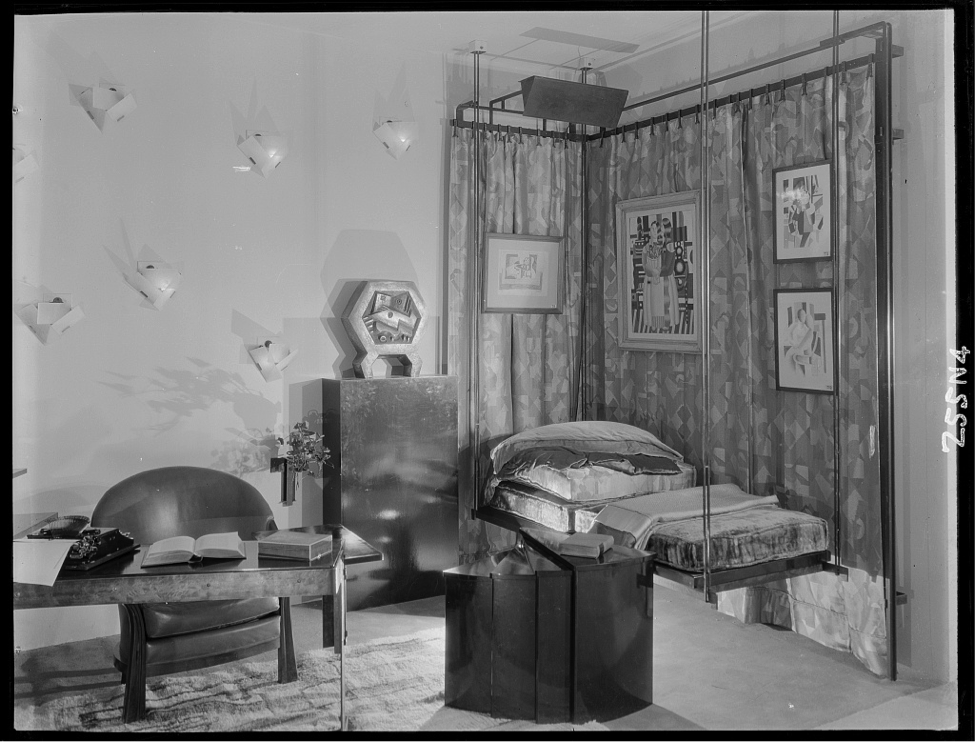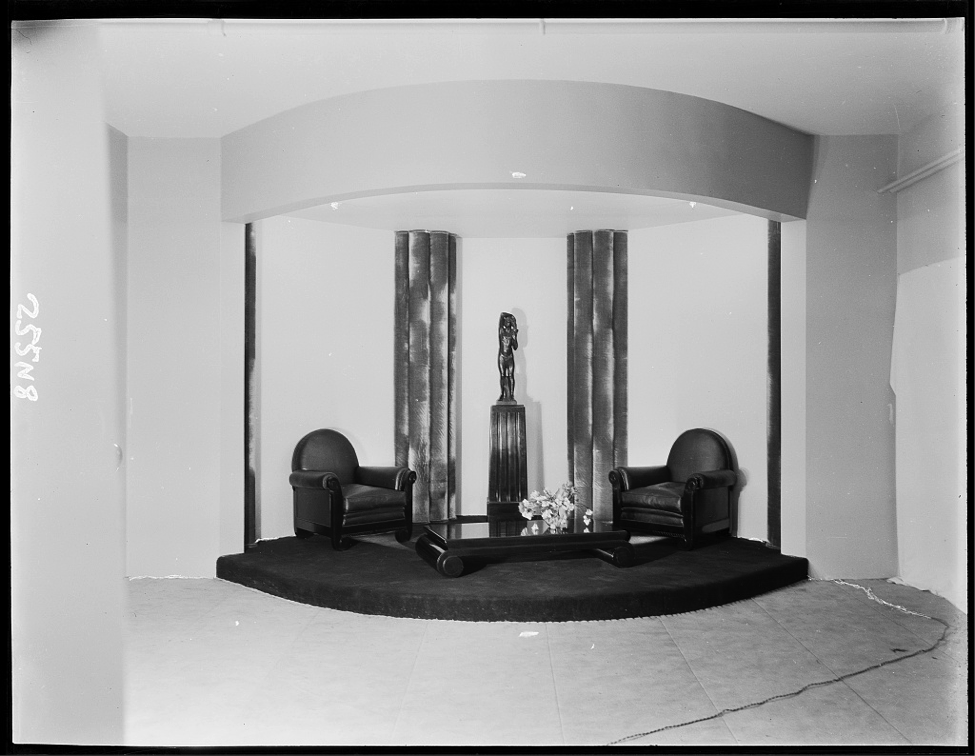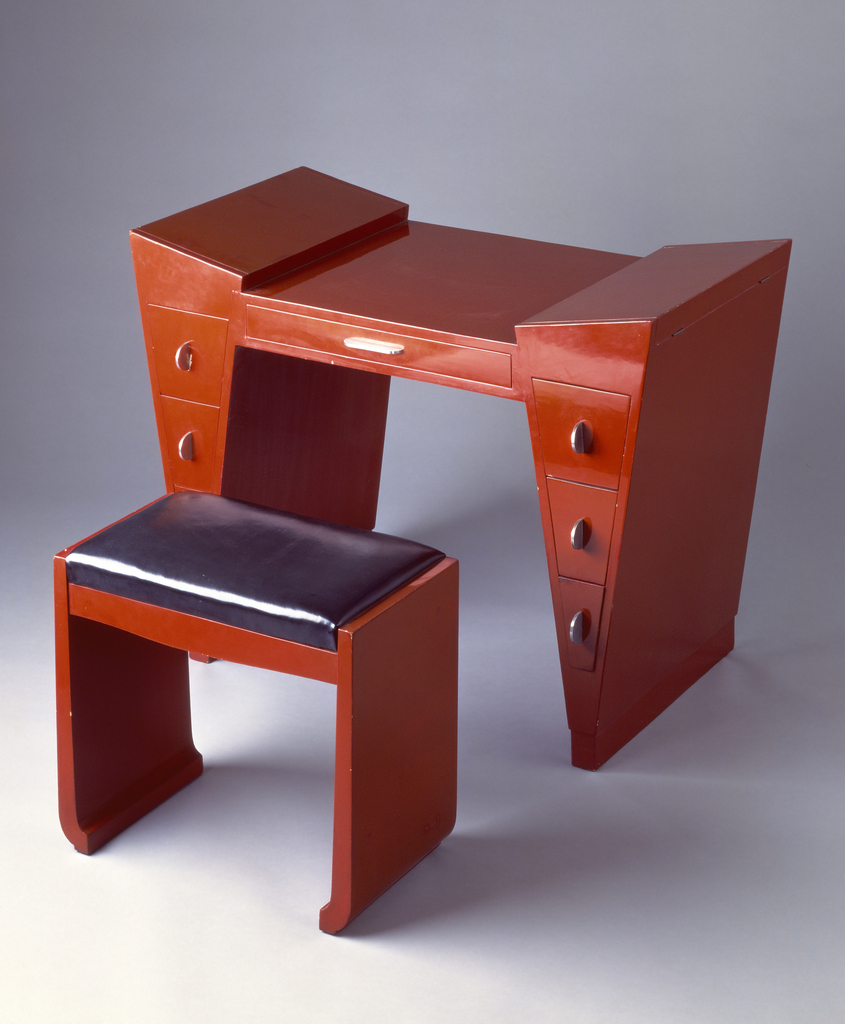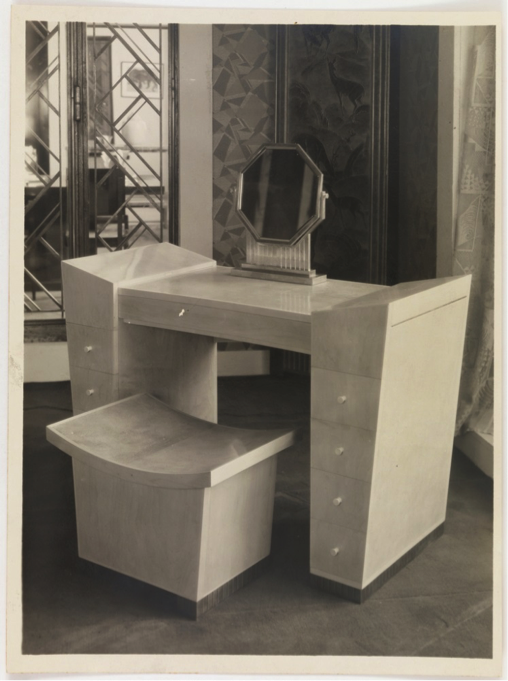In the 1920s, the New York department store was an early promoter and exhibitor of European modernism and a distiller of these new styles for the American consumer. Good Furniture magazine reported in 1928 that “Lord and Taylor has taken a very definite step forward toward the actual placing of modern furniture in American homes.”[1] R.H. Macy & Company, Lord & Taylor, and B. Altman not only exhibited European objects, but also founded their own departments of modern designing to make affordable pieces on site and many took their cue in form and decoration from European models.
In 1928, Dorothy Shaver, Lord & Taylor’s Director of Fashion and Decoration, worked with the architect Ely Jacques Kahn to design an “Exposition of Modern French Decorative Art” to test American taste and buying power for modernism. As the New York Times reported, “The aim of the exposition, according to Samuel W. Reyburn, president of Lord & Taylor, is to determine the reaction of the American public to modern art in all its developments and to ascertain whether there is sufficient interest here to justify activity on the part of American artists, manufacturers, and merchants in the production and presentation of such merchandise as a business venture.”[2] Attendance numbers indicated enthusiasm: from February 23 to April 7, 1928, more than three hundred thousand people attended.
The department store borrowed a period room display strategy (staging objects from a similar time period in one setting, simulating a living environment) from this display practice commonly found in museums. Visitors were invited to wind their way through a series of French groupings separated by room type. For instance, Pierre Chareau designed a study outfitted with furniture in sleek geometries (below).

Photograph, View of Pierre Chareau study at Lord & Taylor, 1928; Photographed by Sigurd Fischer; Retrieved from the Library of Congress, https://www.loc.gov/item/2015651413/
The exhibition showcased the work of leading French modernists, who in addition to Chareau included Jacques-Emile Ruhlmann, Jean Dunand, Süe et Mare, and François Jourdain.[3] By curating coordinated room settings, the department store provided guidance on how to create ensembles of new objects. One review pointed out the transporting effect that the Lord & Taylor’s rooms triggered: “One notes the women putting themselves in the midst of these rooms and wondering if they could live in them.”[4]

Photograph, View of Süe et Mare’s “corner of a living room” at Lord & Taylor, 1928; Photographed by Sigurd Fischer; Retrieved from the Library of Congress, https://www.loc.gov/item/2015651418/
The Jazz Age: American Style in the 1920s includes a great range of objects by these French craftsmen, linked above, that are representative of their signature styles that were exhibited with great acclaim at this important Lord & Taylor exhibition. Also included at the department store were five room settings with American adaptations, designed by Lord and Taylor and executed there. In the exposition catalogue Shaver expressed her hope that American designers could be prompted by the displays “to make their own contribution to this movement” and learn from the French designers to “make for a closer alignment of the artist and manufacturer in the production of beautiful objects for general consumption.”[5] By April of 1929, Lord & Taylor had opened “The Modern Shop,” an in-house cabinetmaking shop to cater to public interest for affordable modern design. A recently engaged, modern-minded American customer Marie-Louise Montgomery ordered a vanity table and bench to be made at Lord & Taylor from a sketch she brought to the store. The realized design is currently on view in The Jazz Age: American Style in the 1920s.

Dressing Table And Bench, ca. 1929; After Léon Jallot (French, 1874–1967); Retailed by Lord & Taylor (New York, New York, USA); lacquered joined wood, mirrored glass, metal; H x W x D (a: dressing table): 79.3 x 105.4 x 60.3 cm (31 1/4 x 41 1/2 x 23 3/4 in.) H x W x D (b: bench): 49.5 x 54.8 x 31.5 cm (19 1/2 x 21 9/16 x 12 3/8 in.); Gift of James M. Osborn; 1969-97-7-a/i
Marie-Louise’s concept for the vanity was directly drawn from a dressing table and bench exhibited by the French designer Leon Jallot at the 1928 Salon des Artistes Decorateurs.

Dressing Table, 1925–35; Leon Jallot (French, 1874–1967); Photograph by Therese Bonney (American, 1894–1978); 20.5 x 25.5 cm.; Collection of Smithsonian Institution Libraries
With two pedestal legs in the shape of inverted triangles and drawers that graduate in width from the widest at the top to the narrowest at the bottom, Jallot’s model is nearly identical in outline to the one that Marie-Louise owned and used. This table’s strict geometries and angularity align it with the formal characteristics of Cubism. While the Jallot model was finished in expensive sharkskin, the Osborns’ table was in lacquer that made it an affordable but still dramatic statement in the interior. This dressing table and bench, along with a Tea and Coffee Service by Puiforcat, the Tourbillons Vase by Suzanne and René Lalique, and an elegant green evening dress with radiating geometries are a few of the many modern objects on view in the exhibition that were made available to American consumers through New York department stores in the late 1920s.
Emily Orr is the Assistant Curator of Modern and Contemporary American Design and served on the curatorial team for the exhibition The Jazz Age: American Style in the 1920s, on view at Cooper Hewitt through August 20, 2017.
[1] N.C. Sanford, “American-Made Furniture in the Modern Trend,” Good Furniture, June 1928, 287.
[2] “Shows French Art to Test Its Value” New York Times, February 29, 1928.
[3] “Lord & Taylor advertisement,” New York Times, April 6, 1928.
[4] Lewis Mumford, “Modernist Furniture” The New Republic, March 21, 1928.
[5] An Exposition of Modern French Decorative Art exh. cat. (New York: Lord & Taylor, 1928), 8.
One thought on “Beautiful Objects for General Consumption: The New York Department Store and Modern Design in the 1920s”
Theresa Leonhardt on September 16, 2023 at 7:37 pm
Could you tell me about this piece of furniture made by Macy’s in 1931? Well, I don’t know how to post a picture of what looks like something that can be turned, and folded out into a small table. It has a hole in the side that looks like a radio could fit. If you could send me a note on my email, I know how to send the picture via email. Very unusual piece.